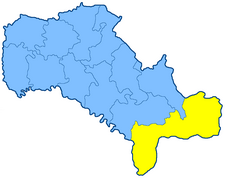Balta uezd
Balta uezd
Балтскій уѣздъ | |
|---|---|
 Location in the Podolia Governorate | |
| Country | Russian Empire |
| Krai | Southwestern |
| Governorate | Podolia |
| Established | 1796 |
| Abolished | 12 April 1923 |
| Capital | Balta |
| Area | |
| • Total | 7,766.25 km2 (2,998.57 sq mi) |
| Population (1897) | |
| • Total | 391,018 |
| • Density | 50/km2 (130/sq mi) |
| • Urban | 5.97% |
| • Rural | 94.03% |
The Balta uezd[a] was a county (uezd) of the Podolian Governorate of the Russian Empire. It bordered the Olgopol and Gaysin uezds to the north, the Uman uezd of the Kiev Governorate to the northeast, the Kherson Governorate's Elisavetgrad uezd to the east, and Ananev uezd to the south, and the Orgeev uezd of the Bessarabia Governorate to the west. Its administrative centre was Balta.
Administrative divisions
The subcounties (volosts) of the Balta uezd in 1912 were as follows:[1]
| Name | Name in Russian | Capital |
|---|---|---|
| Baksha volost | Башканская волость | Baksha |
| Bandurovka volost | Бандуровская волость | unknown |
| Bogopol volost | Богопольская волость | Bogopol |
| Budei volost | Будейская волость | Budei |
| Velikiy-Bobrik volost | Велико-Бобрикская волость | Velikiy-Bobrik |
| Velikaya-Mechetna volost | Велико-Мечетнянская волость | Velikaya-Mechetna |
| Verbovka volost | Вербовская волость | Verbovka |
| Voronkovo volost | Воронковская волость | Voronkovo |
| Golovanevsk volost | Голованьская волость | Golovanevsk |
| Danilova volost | Даниловская волость | Danilova-Balka |
| Korytno volost | Корытнянская волость | Korytno |
| Krivo-Ozerskoe volost | Криво-Озерская волость | Krivo-Ozerskoe |
| Kruty volost | Крутянская волость | Kruty |
| Lipovenka volost | Липовеньская волость | Lipovenka |
| Molokish volost | Молокишская волость | Molokish |
| Moshnyagi volost | Мошнягская волость | Moshnyagi |
| Nestoita volost | Нестоитская волость | Nestoika |
| Pereimka volost | Переймская волость | Sarazhinka |
| Peschany volost | Песчанская волость | Peschany |
| Pisarevka volost | Писаревская волость | Pisarevka |
| Savran volost | Савраньская волость | Savran |
| Triduby volost | Тридубская волость | Triduby |
| Troyanka volost | Троянская волость | Troyanka |
| Troyany volost | Трояновская волость | Troyany |
| Tsybulevka volost | Цыбулевская волость | Tsybulevka |
| Cherna volost | Чернянская волость | Cherna |
| Yuzefpol volost | Юзефпольская волость | Yuzefpol |
Demographics
At the time of the Russian Empire Census on 28 January [O.S. 15 January] 1897, the Balta uezd had a population of 391,018, including 196,111 men and 194,907 women. The majority of the population indicated Little Russian[b] to be their mother tongue, with significant Jewish, Romanian and Russian speaking minorities.[4]
| Language | Native speakers | Percentage |
|---|---|---|
| Little Russian[b] | 300,543 | 76.86 |
| Jewish | 53,066 | 13.57 |
| Romanian | 17,583 | 4.50 |
| Great Russian[b] | 15,188 | 3.88 |
| Polish | 3,344 | 0.86 |
| German | 260 | 0.07 |
| Gipsy | 243 | 0.06 |
| Tatar | 242 | 0.06 |
| Czech | 205 | 0.05 |
| Belarusian[b] | 109 | 0.03 |
| Latvian | 46 | 0.01 |
| Mordovian | 29 | 0.01 |
| Chuvash | 25 | 0.01 |
| French | 18 | 0.00 |
| Bashkir | 5 | 0.00 |
| Votyak | 3 | 0.00 |
| Cheremis | 1 | 0.00 |
| Other | 108 | 0.03 |
| Total | 391,018 | 100.00 |
Notes
- ^
- ^ a b c d Prior to 1918, the Imperial Russian government classified Russians as the Great Russians, Ukrainians as the Little Russians, and Belarusians as the White Russians. After the creation of the Ukrainian People's Republic in 1918, the Little Russians identified themselves as "Ukrainian".[2] Also, the Belarusian Democratic Republic which the White Russians identified themselves as "Belarusian".[3]
References
- ^ Волостныя, станичныя, сельския, гминныя правления и управления, а также полицейские станы всей России с обозначением места их нахождения [Volostny, stanichnaya, rural, communes of government and administration, as well as police camps throughout Russia with the designation of their location]. Kiev: Izd-vo T-va L. M. Fish. 1913. p. 161. Archived from the original on 2022-12-11.
- ^ Hamm, Michael F. (2014). Kiev: A Portrait, 1800–1917. Princeton University Press. p. 83. ISBN 978-1-4008-5151-5.
- ^ Fortson IV, Benjamin W. (2011). Indo-European Language and Culture: An Introduction. John Wiley & Sons. p. 429. ISBN 978-1-4443-5968-8.
- ^ a b "Демоскоп Weekly - Приложение. Справочник статистических показателей". www.demoscope.ru. Retrieved 2019-12-19.

